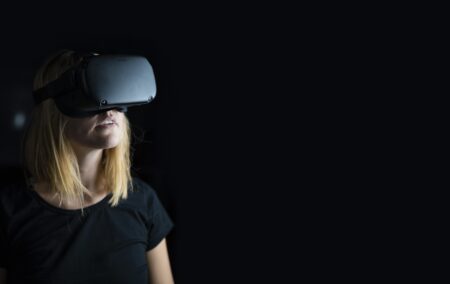TechCrunch, a leading technology website, says “Apple’s Vision Pro will live or die on the backs of developers.” That’s probably true.
The most startling advance in this spatial computing product is image clarity. Immersed within the customized headset, near the end of a 30-minute demonstration, a giant shark is speeding straight towards your head. You’re tempted to wince or get out of the way. Similarly, in the stunning video of the young woman tightrope walking across a chasm with roaring water far below, you feel you’re walking with her.
For me, it was a new experience to control icons arrayed before you by touching a forefinger to thumb, or to expand an image by bringing the fingertips of both hands together and then pulling apart. I was equally amazed to see an icon respond from my eye looking directly at it.

Downsides
There are downsides. A Vision Pro starts at $3 500 and for now is available only in the US. The handsome carrying case would seem to be essential but it costs an extra $200. The headset rests rather heavily upon your head. It weighs 600 grams (21 ounces). You can’t bring glasses into the Vision Pro, but your vision coordinates are dialed into unobtrusive optical inserts. They too cost additional money.
Some users, especially women, will complain that the headset musses up their hair. The device is connected by cord to a battery pack whose charge is said to be good for a bit more than two hours.
This new device may or may not be transformative. Not surprisingly, Apple CEO Tim Cook believes it is transformative, saying “the Vision Pro changes everything.” The technology is tailor-made for multitasking. You can watch multiple sporting events in real time, for example, several basketball games lined up in a row, each broadcast available to be expanded or zoomed. The head of the National Basketball Association claims that Vision Pro is better than sitting courtside. He sees it as a tool for expanding the NBA to a global audience.
Gamers
Gamers are likely to be excited by the possibilities of spatial computing. It depends on the extent to which developers produce new applications that, of course, will be available through the Apple store. Apple users will be able to transfer their photos into Vision Pro and writers can attach a keyboard.
Some enthusiasts believe Vision Pro rivals the iPhone or Mac in significance. The first Mac was released 40 years ago and the iPhone in 2007. The Vision Pro’s release comes two years after Facebook’s Mark Zuckerberg unveiled his Oculus headset, which he boasted would be “an embodied internet where you’re in the experience, not just looking at it.” Zuckerberg was so convinced that Oculus — now rebranded as Quest — would be so transformative that he changed the name of the company to Meta, which means ‘beyond.’ The Quest headset can be purchased for $500, but its capacities are limited compared to Apple’s.
(My video perspective from two years ago on Oculus and Meta can be viewed here)
Technological advances are racing ahead in the Silicon Valley. This past year the buzz has been Chat GPT, the artificial intelligence application in which Microsoft is a major player. In part because of Chat GPT, Seattle-based Microsoft has leapfrogged Apple to become the world’s most valuable company by market capitalization. Meta is the world’s seventh largest company, its market cap exceeding one trillion dollars.
Is Apple’s Vision Pro an America product? Yes, according to where the device was created and programmed, but no as to where it is manufactured, which is in China by Taiwan’s FoxConn, Apple’s production partner. Clearly proud of how the Vision Pro is made, Apple has released this video about its largely automated production.
As to whether Vision Pro is transformative, we’ll have to wait and see. *
The views of the writer are not necessarily the views of the Daily Friend or the IRR
If you like what you have just read, support the Daily Friend

